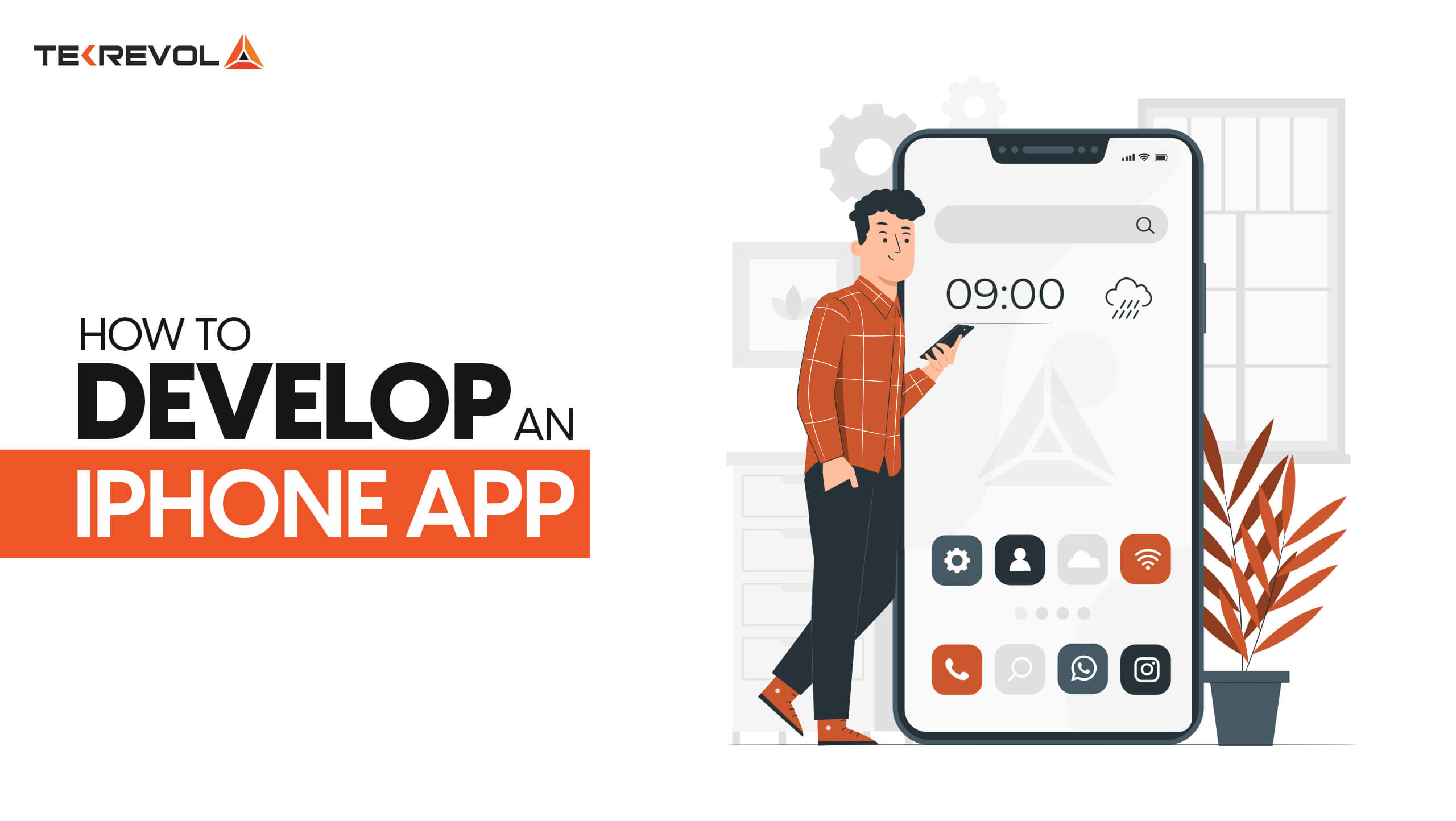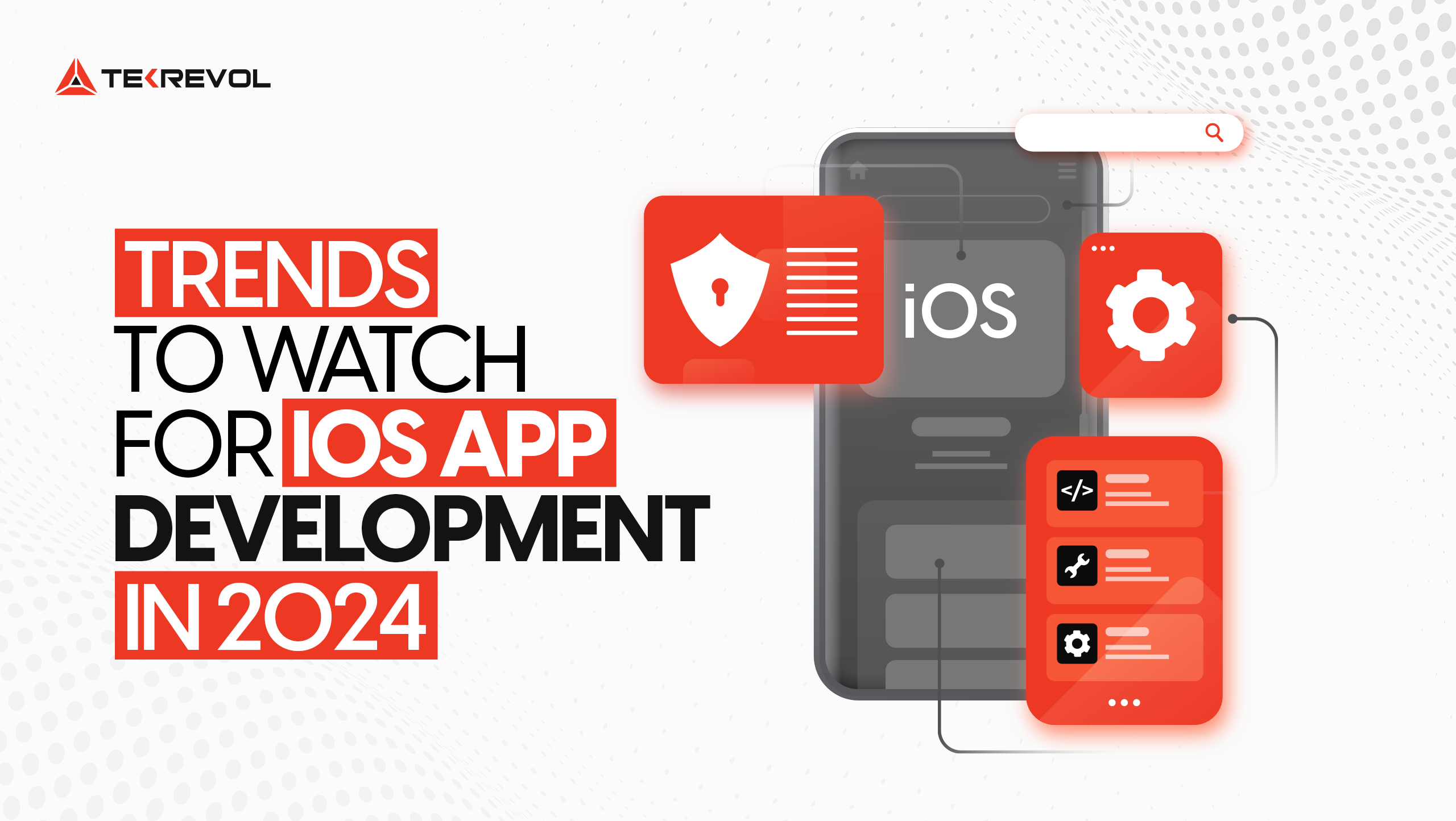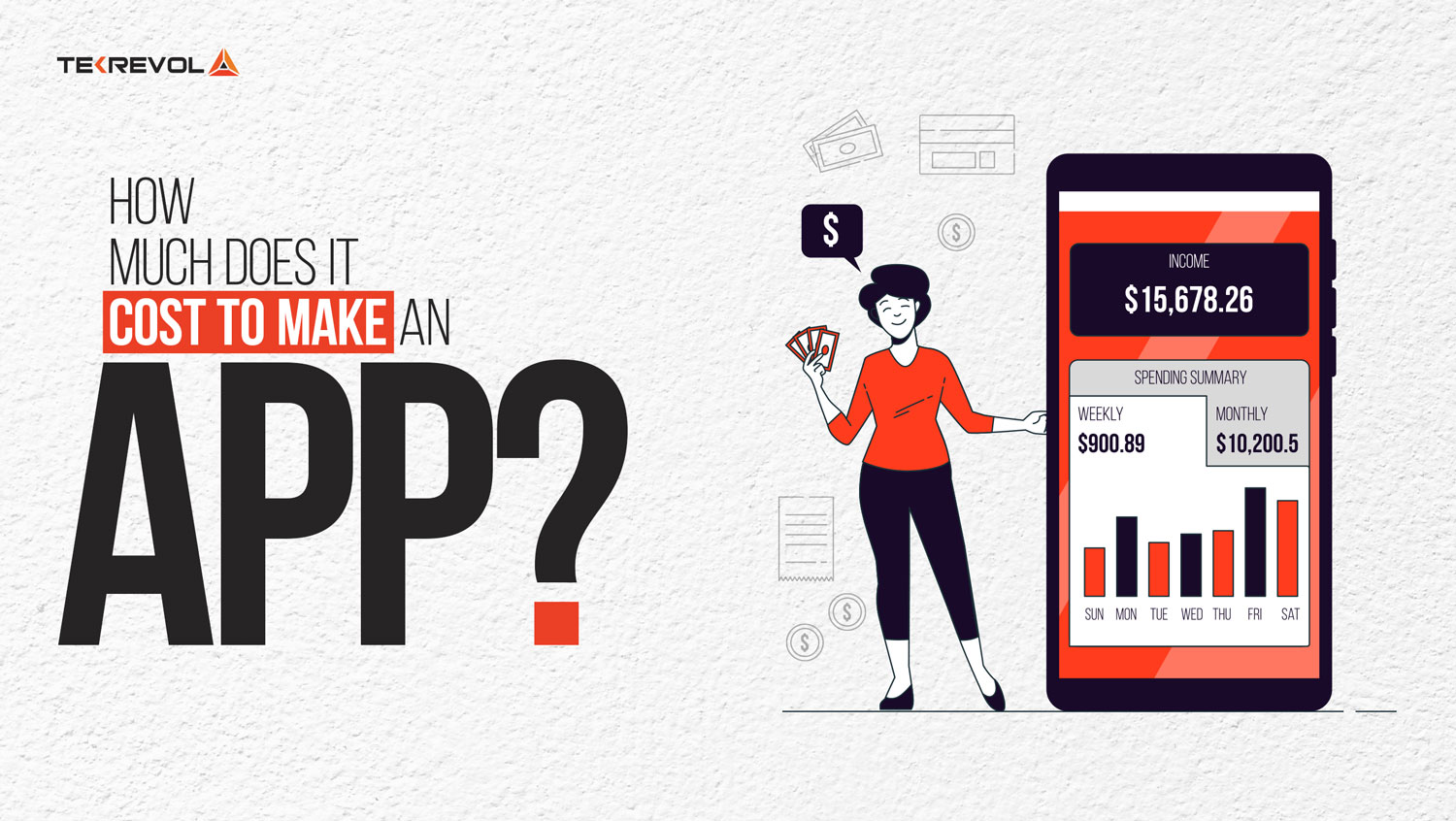How to Develop an iPhone App? – A Complete Process Guide
- IPhone App
- |

There are almost 2.2 million apps for iPhone users. Now you, too, have an idea for an iPhone app, but you start wondering if it will survive the competition on the Apple Store.
How to develop an iPhone app that good? What tools do you need for building this app? Will it generate planned revenue? How much will iPhone app development cost? How long will it take to develop your iPhone app?
If any of these questions have lately crossed your mind, this article is for you.
Considering the growth of the Apple Store and Android users switching to iPhones because of performance and UX, most of our readers had similar questions. So, Tekrevol’s business analysts and developers have compiled this guide to answer the 6 most frequently asked questions about how to develop an iPhone app:
- How much does it cost to develop an iPhone app,
- Which features should you add to your iPhone app,
- Which tools and technologies are used in iPhone app development,
- How to hire iOS app developers for your iPhone app,
- How to test an iPhone app and ensure a high-quality user experience,
And finally,
- How to make money with your iPhone app.
Without further ado, let’s dive in the process of iPhone app development.
What is iOS development?
iOS development is the process of building digital solutions, apps, games and widgets for devices that run on the iOS operating system or say, Apple’s mobile operating system. These devices include iPhone, iPad, Apple Watch and Apple TV.

Why do businesses invest in iOS development?
iOS and Android are the two leading app marketplaces in the global tech arena. In fact, iOS is one of the most popular operating systems powering millions of devices like Apple smartphones, Apple watches etc. Developing an iOS product means you can acquire a decent chunk of users in the ready market.
Especially for iPhone apps, the market is even stronger because this device prioritizes usability and value. Lastly, Apple as a brand name is enough. And if you wish to penetrate the global digital business ecosystem, there is no better place than positioning your app well in the App store.

This is the interface of Tekrevol’s recent iPhone app development project, Estate Pie. It’s a real estate app for property managers and tenants. Our client realized the potential of iOS development early on and chose to penetrate the property market with a mobile-first approach.
Developing an iPhone App: Key Considerations
Budget Factors: How much does it cost to develop an iPhone app?
As soon as you plan to invest in any technical venture, whether you are up for developing a basic mobile app or a high-magnitude SaaS product, the concerns related to budget and cost of app development will hit right away.
With years of experience in the industry, we also highly recommend startups and new appreneurs to find out cost estimates in the earlier stages of business. Taking this smart move will further guide you to your next step and help you decide if you should:
- Build an MVP or fully-featured app
- Develop a native app or a cross-platform app
A mid-level iOS app costs an average $75,000. This includes design, development, testing and pre-launch maintenance.
Here is a more detailed breakdown of iPhone app development costs:
- A basic iPhone app costs $30,000 – $50,000.
- A multi-feature iPhone app costs between $60,000 – $100,000.
- An advanced iOS app with support for iPhone, iPad and Apple Watch costs $110,000 – $200,000.
- A business iOS app built using native iOS tools will cost more than $200,000.
- Want real estimates of your iPhone app’s cost?
Development Period and Time Duration: How long does it take to develop an iPhone app?
Mid-level iPhone app development can take an average of 8 months, including the testing and quality assurance procedures.
Basic iPhone apps take around 5 months, multi-featured apps take between 6 to 8 months and advanced apps can be completed in 15 months. High-magnitude business apps with heavy features, multiple payment integration modules, AR and VR capabilities, and blockchain and machine learning integration can even take more than 18 months.
App Idea
This is one main key consideration you need to take care of when launching an app for iPhone. While Google Play has some decent rules to abide by, Apple’s App store is stricter and puts every app through rigorous testing. Apple has a bigger ratio of premium paid applications as compared to the Google Play store.
iPhone users value experience, performance, navigation and the value of money or time they invest. This means any app you plan to launch should not be a replica of an existing digital solution. It should be original, inspired by creativity and directed towards making a difference – either through its cost or experience.
macOS Requirements
Developers can only build an iPhone app on a macOS device.

Doing so on Windows is not possible. Some independent developers try to create remote connections, then download Xcode to develop iOS apps. This is not recommended and an app can end up with bugs if still practiced.
How to develop an iPhone app
1. Assess your requirements and app development goals
As we mentioned earlier, the success of your iPhone app idea duly depends on its originality – or a unique approach to presenting it. To make it successful and profitable on the App Store, here are five key factors about your app that we recommend you consider even before you hire an iOS developer to build your product.
a. Competitor analysis
Competitor analysis is the first step in your market research. When looking for apps to seek design and development inspiration, create a list of 3 to 5 apps – only with a rating of 4.5 or above. Then check if they have an Apple Watch version, when they have published the app, what their app does and so on.
b. Target audience
The target audience ultimately makes a difference to your app design and features. If you are launching an app for kids, it has to have a specific branding and attractive colors. If your app is for adults, let’s say in the education sector, it has to have sophisticated branding with easy navigation. Similarly, if it’s for corporate users, it should follow a minimalist style.
c. Platform
This is a factor you already have in mind as you start with your project. You know you want to make an app for iPhone users, plus you have to design screens for iPad. Don’t keep the designs too specific for iPhone if you have plans to scale your business and launch a version for Android in the future.
d. Monetization model
Now when you have the list of apps, look at their monetization strategies. Most apps make money through these methods:
- Free apps earn through sponsored ads. Some of them earn through in-app purchases.
- Premium apps charge either a one-time download fee or monthly subscription charges to continue using the app.
- Freemium ads earn through a mix of ads, in-app purchases and premium subscriptions.
Read this article for a more detailed insight into the revenue models for iOS and Android apps.
e. Ratings and reviews
You can add a level of originality or uniqueness to your app even if your idea is inspired by an existing solution. Go to the official App store listings of the specific apps and read through users’ comments. Look at the feedback and filter the common ones. Critically examine if the app has 1- and 2-star reviews and check the nature of users’ complaints.
Your market research at this stage is quite complete. Now you need to take a step ahead and create a development strategy for your app. Write down everything you want your app to do, every task you want it to perform, and how well. Write down all the business and financial goals you want your app to fulfill.
2. Decide iPhone app features
Once you have a quick rough idea of how your app will perform and the target audience for your app, it’s time to decide ‘how’ it will technically do all that you have planned. For this, you need to figure out which features you want to add to your app.
From basic to intermediate to advanced features, you need a mix of them to make your app user-centric and successful in the app store.
Here are common features in most iPhone apps now:
- Email sign-up, guest sign up and social sign up
- Personalized recommendations, push notifications and custom settings
- App analytics and screentime
- Dark and offline modes
- Data security and privacy
- Multiple payment options with Apple Pay, Amazon Pay and credit cards
- Voice and image search
- Multi-device synchronization
- Multi-language support

Again, which features you add to your app totally depends on the scope of your project. Think about your target audience here and see which ones they need, which ones they don’t and which ones will be nice to have without cluttering the user interface and user experience.
3. Create a technology stack for your iOS app
A technology stack is basically a set of development tools and technologies, programming languages, custom software development toolkits, frameworks, environments, APIs and frameworks that developers use to create software.
A technology stack and its components depend on the digital product you or your developer wants to build. Here is the ideal technology stack used for developing an iPhone app:
Objective-C and Swift: These are primary programming languages global iPhone app developers use to create compelling iOS applications.
a. Objective-C
Objective-C is the first main programming language used to code iOS and macOS mobile applications. Developed in the 80s, it has 2 code blocks: header interface files and implementation files.
Features of Objective-C
- It is a more mature language, so it has become an industry standard for iOS app development.
- It is a stable programming language. For reference, Objective-C does not have updates as regular as in Swift.
- Connecting with private APIs is way easier in Objective-C, making custom code changes during mobile app development convenient and less time-consuming.
- Objective-C is compatible with C and C++ specifications.
b. Swift
Swift, according to Apple’s official developer website, is a powerful and intuitive programming language. It is easy to learn and use and modern enough for coders’ convenience. Swift provides more freedom to Apple developers building applications for iOS, macOS and wearables.
Completely developed by Chris Lattner in 2014, Swift is open-source, primarily based on C++.
Features of Swift
- It is a modern language, a result of recent research and development activities.
- It is faster and more powerful than Objective-C. So, developers can swiftly create fast-loading, fully-functional applications using Swift or flutter.
- Swift eliminates garbage collection by automatic memory management and reference counting.
In comparison, 8% of developers are experienced in Swift while 7% are experienced in Objective-C. Because Swift is modern, developers are quickly switching to Swift programming language for mobile app development, yet popular app development agencies still offer both.
c. Xcode
Xcode is an official Integrated Development Environment for building digital products for iOS, macOS, watchOS and tvOS. Because Apple itself has launched this environment for programming, it is considered a holistic tool for building apps that go on the Apple store.
Considering the primary importance Apple has given to the frameworks and libraries in the Xcode, beginners to experienced iPhone app developers prefer using this environment when coding iOS apps.
d. SwiftUI
As the name suggests, SwiftUI has root associations with app user interfaces. Like Swift, SwiftUI is also an official UI building framework from Apple. Apple’s previously recommended UIKit has recently replaced it with SwiftUI after it learned its programming and designing lessons from UIKit.
SwiftUI is modern, more stable, and developer-friendly, and helps create user interfaces that are uniform yet versatile.
In addition to these tools, iPhone app developers use cloud services, databases and testing libraries in different stages of development and API integration. Python is also a strong programming language turned backend framework that has played a crucial role in sustaining the most successful iPhone apps we use today.

Know that these are recommended tools and technologies commonly used for iPhone app development. Your developer may use additional libraries, frameworks or different ones depending on the technical requirements of your project.
- Want a technical expert to create your tech stack?
- Learn everything you need to know about the types of AR apps, current market trends, technical aspects, and much more in our articles.
4. Hire a team of iOS app developers
You need a team of professional iOS developers to build an iPhone app. If you are from a business background with a limited grip on coding with Swift, then you need at least these five professionals to complete your project:
- Project manager: a PM works as a business analyst, a research and development professional, cost controller, coordinator, and in some cases, also a product manager from the beginning.
- UI and UX designer: this creative individual (or a small team) designs the app screens. They take the approved app flow and user journey, user profiles and ideal user persona from the project manager and create rough sketches to high-fidelity prototypes of the app.
- Frontend developer: this individual creates the client-side of the iPhone app – the part that directly interacts with the user.
- Backend developer: this individual creates the server-side of the iPhone app – the part that processes and fetches data, powers the frontend, holds the features and lets APIs work in the background.
- QA and testing professional: this individual (or a team) ensures the app is digitally correct, technically error-free, and doesn’t have bugs or viruses in its major builds. From loading time on different iOS devices to crashing, this department takes care of everything quality-related.
What are your options for hiring an iPhone app developer?
· DIY
As you can see, this team of iPhone app developers is responsible for a mix of coding and administrative tasks. If you are planning to build your own app, you have to have intermediate to expert-level skills with programming languages and the technology stack we have discussed in the earlier sections.
While you should have hands-on experience working with Swift or Objective-C, databases and APIs, testing tools and instruments, you also need project management skills to complete your planned milestones in time.
· In-house Team
If programming your iPhone app yourself isn’t an option, the second one is hiring an in-house, onsite development team with these five professionals for dedicated tasks. This could be a great hiring option if you check BOTH of these boxes:
- Want to fully engage in the development process during major business hours
- Have cashflows to manage office expenses, recruitment costs, full-time wages and benefits
- Are you comfortable with producing, arranging and acquiring necessary documentation like licenses, bank accounts, income tax procedures
· Outsourcing Locally
If you do not meet either of the boxes above, you definitely should consider outsourcing your app development project to a local development team and managing the process remotely.
In outsourcing, you shortlist two to three iPhone app development agencies (or companies if you want to go big), assess their technical expertise, study their portfolio and their technology stack, look at their pricing structures and commitments, and their non-disclosure agreements.
Then you look at the fixed cost of app development and make your hiring decision by balancing three or more of these factors.
Your brief starts even before you have legally hired an app development company for your project. After the discovery stage, the UI and UX designers start creating the app screens and digital assets for the app.
Once the client (you) approves the app design, the same is forwarded to the development departments for establishing the frontend and backend foundations of the app.
Throughout the technical coding part, development and testing teams work collaboratively to ensure the app build has no errors.
· Staff Augmentation
Staff augmentation works like a subscription model in the hiring industry. You contact an app development or staff augmentation firm and brief them about your project’s technical requirements. These companies provide a list of matching resources and you can shortlist 4 to 5 developers depending on the strength of their profile.
Then the traditional model of technical interviews follows, and you can create a custom team with professionals of your choice. You can manage this team remotely, choose working hours with mutual consent and pay for the hours they work. That’s it – no full-time benefits, income taxes, benefits or office expenses.
5. Complete design and technical specifications
There are two common terms every app developer will use: user interface and user experience.
For reference, the user interface has more to do with the design stage of an app. Based on these designs, developers create the backend and frontend of an app which ultimately translates into the user experience.
For the design part, UI/UX designers start with creating app wireframes. This happens when the project managers brief the app flow and map a user journey within the app.
So, you can say that the development brief, market research, user journey, and wireframes are all part of the app’s creative strategy. These wireframes are initially low fidelity diagrams that give a rough idea of an app’s core functionality. Then these are turned into high-fidelity, visually active prototypes.
Depending on your budget as well as timelines, you may or may not want to create a high-end prototype. Your technical development part can start right after your screen designs are ready. However, if you are seeking investment and pitching to venture capitalists for external funding, you may want to consider startup prototyping to secure planned cash flows.
For reference, designers use tools like AdobeXD to create these high-fidelity prototypes. There are other mobile app wireframing tools, but Adobe Creative Cloud has set the bars high.
Recommended Read: 10 Wireframe Tools for 2022
For the development part, the team starts with building the frontend of the app on the designs. A frontend is basically the client side of an application – the features that directly interact with your app users.
Then they move ahead to building an app’s backend. This is the server-side that stores, loads, fetches and communicates data. This is the part that powers the frontend and enables users to use the features they find on their screen.
Third up is API integration. APIs, you can say, are small applications that communicate with two different apps. Digital payment gateways and Google maps are the common APIs. Using these APIs in your app will allow you to significantly reduce the time and development effort you’d otherwise need for building a feature from scratch.
Once these development stages are done, your iPhone app is technically ready. It now needs to be assessed for technical issues. If your iPhone app development team follows agile methodology, it would definitely test your app build on each new level of development, improving it in real time, and wouldn’t leave much for the end.
6. Test the app and publish
There are dedicated teams for testing iPhone apps. These teams have access to special instruments, devices with old and new iOS versions, frameworks and penetration technology stack for ensuring the quality of an app. All app tests are performed to ensure user experience, functional accuracy and data security. Here are 8 most important standards that testers and QA professionals assess during the app testing stages:
- Blending of apps screen designs, backend development and UX
- App’s loading time and speed
- Working of features
- In-app navigation and performance
- Bugs and viruses
- Sign up, sign in and app crashes
- Functional digital payment methods
Data protocols and retention

This stage identifies technical and experiential triggers in your app. Once they are fixed, your app is ready for submission at the Apple App store. To do so, you’ll need an Apple developer’s account, which costs $99/year. In the case of NGOs or governmental organizations, you’ll have to submit a request and Apple may decide to waive off this fee.
Wrapping Up…
This comprehensive guide on how to develop an iPhone app concludes here. And this is where your practical business decision-making part starts. You began with an idea and it is now time to bring it to reality.
To further this, your next step includes maturing your idea with strong market research, figuring out your app features, hire android developer and preparing a technology stack for your app.
We recommend all appreneurs to keep close attention to detail and monitor their milestones strictly to launch the app in time. For the testing time, ensure you too assess the app for technical and usability factors and ensure your app goes battle-tested and error-free on the store.
- Building your own iPhone app?
- Tekrevol can help you with all things development-related. Partner up with creative designers and experienced developers and witness your idea unfold into a profitable digital reality! Complete app discovery, get the quickest estimates of cost, and start building!
Author : Saba Sohail
Saba is all about strategic leadership and tech-led transformation. She comprehends, incubates, and iterates the idea of integrating tech-powered solutions and converts her knowledge into simple, valuable, and actionable blogs for tech leaders and businesses, much like TekRevol does with their products and solutions.
Come meet us at a location near you!
 USA
USA
39899 Balentine Drive,
Newark, CA 94560
1301 Fannin St #2440,
Houston, TX 77002
501 E Las Olas Blvd Suite
230, Fort Lauderdale, FL
44 Tehama St, CA 94105, San Francisco
400 NW 26th St, FL 33127, Miami
740 15th St NW 8th Floor, DC 20005, Washington
 CANADA
CANADA
4915 54 St 3rd Floor
Red Deer, ABT T4N 2G7
 UAE
UAE
Level 5, One JLT Tower 1 - Jumeirah Lakes Towers - Dubai, United Arab Emirates
Level 17, World Trade Center, Khalifa Bin Zayed the First Street, Abu Dhabi
Level 22 , West Tower, Bahrain Financial Harbour, Manama, Bahrain
Level 22, Tornado Tower, West Bay, Doha, Qatar
 PAKISTAN
PAKISTAN
3/25, Block 5, Gulshan-e-Iqbal,
Karachi, Sindh 75650




Let’s get in touch!
Let’s discuss your project and find out what we can do to provide value.
I am interested in discussing my ideas with you for
COPYRIGHT 2024 TEKREVOL ALL RIGHTS RESERVED.





